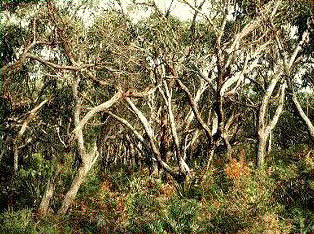Ecotypes: Messmate Ecotypes
Two of the Otway forms of
E.obliqua
grow on starkly contrasting soil types. The first, a tall forest form grows on fertile acidic loams (pH 5 - 6),
which are derived from mudstones, while the second, a low woodland form (5 - 7 m) grows
on poorly structured alkaline soils (pH 7 - 8+) derived from wind-blown calcareous sands.
The occurrence of this second form is interesting because few plant species are adapted to grow on alkaline soils.
Dr Chris Anderson investigated these two forms. He found that when E. obliqua seedlings from forest populations on the acidic soil are transplanted into woodland populations on the alkaline soil they become severely chlorotic and die from summer drought, whereas seedlings from the local population remain green and healthy. This result suggests that these two forms (i.e. forest and woodland) are distinct ecotypes.

Low woodland of E. obliqua on calcareous sand. The thick shrubby understorey includes Leucopogon parviflorus , Epacris impressa and Banksia marginata .
